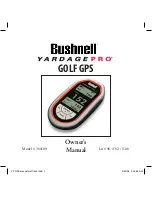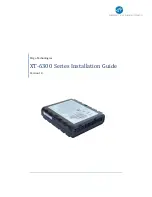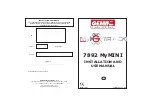
BER : 99
Channel : 737
Cell ID : 3441
Base Station ID : 40
Local Area Code : 31003
Network Code : 410
Country Code : 310
IMEI (Modem S/N): 351802055396182
IMSI (SIM ID) : 310410202524377
ICC-ID (SIM S/N): 89014102212025243778
Phone Number :
GPRS APN : ISP.CINGULAR
Maint. Server : maint.vehicle-location.com(216.177.93.246):20500
Inbound Server : (0.0.0.0):20500
Dual Comm : routing id=0, log cid=0, modem type=21, inbnd index=0
OK
If any of the responses return Not-Acquired or Not-Registered (and the APN is correct), the wireless network operator should be contacted for
further troubleshooting.
Please note that it may take several seconds (or longer) for the LMU-5541
™
to communicate with the modem and acquire the wireless network.
5.4.2 GPS Verification
The next step is to verify that the GPS receiver is seeing enough satellites to obtain a valid GPS position. Again, installers have two choices on
how to perform this verification. First, like the Comm Verification, there is a
GPS status LED (i.e., the one closest to the SMA connector). If this LED is solid, then the LMU has found GPS service.
If the LED is not visible then GPS service may be verified using an AT Command:
AT$APP GPS?
The response should be similar to:
Lat=3304713, Lon=-11727730, Alt=0
Hdg=113 Spd=0 3D-RTIME HDOP=130 nSats=7
Installers are looking for the 3D-RTIME setting along with a valid Lat, Long pair (i.e. something other than 0). If the GPS receiver does not have
a valid lock within 2-3 minutes, installers should check antenna placement
(see the Installation Notes section for placement suggestions), the antenna connector and that the antenna has a clear view of the sky. For further
troubleshooting, installers should contact CalAmp Support
([email protected])
5.4.3 Inbound Verification
The last item to verify is that the LMU-5541
™
is sending data to the correct server. In general, this is a two-step process that will need the aid of
an observer on the back end. That is, a technician will have to be logged in so
they can monitor data coming into the backend mapping/vehicle management application.
First, verify that the LMU-5541
™
is using the correct Inbound IP address by using:
AT$APP INBOUND?
The response should be similar to:
LMU-5541 Hardware & Installation Guide
27/49
INBOUND LMD
INBOUND 0 ADDR ddd.ddd.ddd.ddd:ppppp *
INBOUND 0 URL myURL.myCompany.com
INBOUND 1 ADDR 0.0.0.0:20500
INBOUND 1 URL
INBOUND 2 ADDR 0.0.0.0:20500
INBOUND 3 ADDR 0.0.0.0:20500
The installer will need to verify with a backend technician that the, URL (myURL.myCompany.com ), IP address (ddd.ddd.ddd.ddd) and port
(<ppppp>) are correct.
The second step is to verify that the LMU-5541
™
is sending data. The best way to do this is to force the LMU-5541
™
to send in an
unacknowledged Event Report (i.e., its current GPS location) with the following
command:
AT$APP PEG SUNRPT 255
The LMU-5541
™
will respond with: OK
The backend monitor must then be contacted to confirm that they received an Event Report with Event Code 255.
Assuming that all three sections have passed, the installation can be considered to be complete.
5.4.4 Verification via SMS
The current Comm, GPS and Inbound status of a GSM LMU can be obtained via SMS provided you have access to an SMS capable phone or
PDA.
Using your handset, send the following SMS Message to the LMU:
!R0
Within a few minutes, the LMU should return a response in the following format:
APP: <App ID> <Firmware Version>
COM:<RSSI> [./d/D][./a/A][./L][IP address] [<APN>]
GPS:[Antenna <Short/Open/Off>] | [No Time Sync] | [<FixStatus> <Sat Count>]
INP:<inputs states> <vehicle voltage>
MID:<mobile ID> <mobile ID type>
INB:<inbound IP address>:<inbound port> <Inbound Protocol (LMD/LMX)>
APP: <App ID>:
The Application ID value of the LMU indicating the host platform and the wireless networking technology of the LMU
<Firmware Version>:
The current firmware version in use by the LMU
COM: <RSSI>:
This is the signal strength the wireless modem sees from the network. In general the LMU is at least scanning for the network if the RSSI is not -
113.
[./d/D]:







































